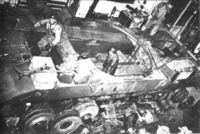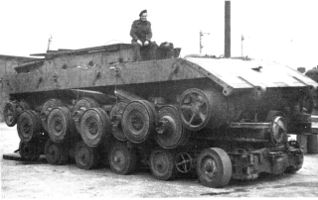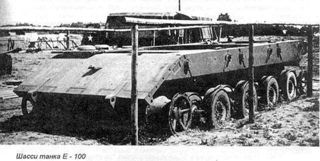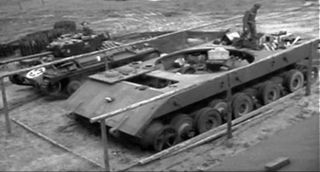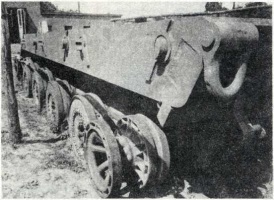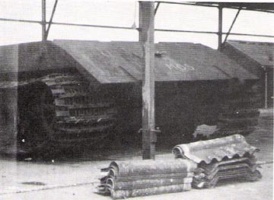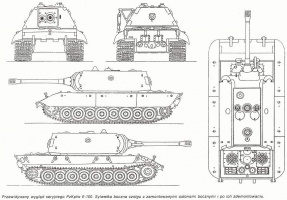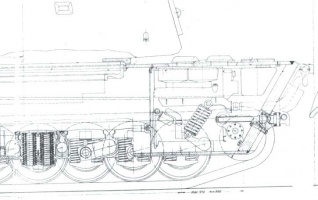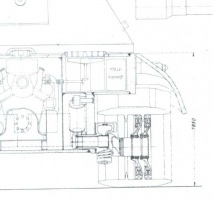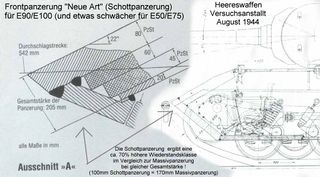E 100
E-100 (Stock)
| 6100000 Preis |
| 2300 SPRobustheit |
| 129.69 / 150 Gewicht |
- Kommandant
- Richtschütze
- Fahrer
- Funker
- Ladeschütze
- Ladeschütze
| 200/120/150Wannenpanzerung(Front/Seiten/Heck mm) |
| 250/150/150Turmpanzerung(Front/Seiten/Heck mm) |
| 1200 PSMotorleistung |
| 30 km/hHöchstgeschwindigkeit vorwärts/rückwärts |
| 20 °/sDrehen/Wenden |
| 460 damage |
| 246 mmMittlere Durchschlagskraft |
| 13 Dauer für vollständiges Nachladen |
| 16 °/sGeschützrichtgeschwindigkeit |
| 250 mSichtweite |
| 500 mFunkreichweite |

The E-100 is a German tier 10 heavy tank
The last tank of the Entwicklung series, the E 100 is more mobile than the Maus, but is less armored. It can also mount the 15cm KwK 44 L/38 gun, which gives the E 100 more alpha damage while having less penetration and a longer reload.


Turm
| Stufe | Turm | Turmpanzerung (Front/Seiten/Heck mm) | Geschützrichtgeschwindigkeit (°/s) | Sichtweite (m) | Erfahrung | Gewicht (t) |
|---|---|---|---|---|---|---|
| X | E 100 | 250/150/150 | 16 | 250 | 0 | 58000 |
| Stufe | Geschütz | Mittlere Durchschlagskraft (mm) | Feuergeschwindigkeit | Streuung auf 100 m | Zielerfassung | Erfahrung | Gewicht (t) | |
|---|---|---|---|---|---|---|---|---|
| X | 12,8 cm Kw.K. 44 L/55 | 246/311/65 | 460/460/600 | 4.62 | 0.38 | 2.9 | 0 | 3480 |
| X | 15 cm Kw.K. L/38 | 235/334/85 | 640/640/960 | 3.49 | 0.4 | 2.9 | 64800 | 3650 |

Motor
| Stufe | Motor | Motorleistung (PS) | Brandwahrscheinlichkeit bei Treffer | Erfahrung | Gewicht (t) |
|---|---|---|---|---|---|
| X | Maybach Neues Projekt | 1200 | 15 | 0 | 750 |

| Stufe | Fahrwerk | Maximalgewicht | Drehen/Wenden (°/s) | Erfahrung | Gewicht (t) |
|---|---|---|---|---|---|
| X | E 100 | 150 | 20 | 0 | 30000 |

Funkgerät
| Stufe | Funkgerät | Funkreichweite (m) | Erfahrung | Gewicht (t) |
|---|---|---|---|---|
| X | _10WSc | 500 | 0 | 160 |
Compatible Equipment
Compatible Consumables
Player Opinion
Pros and Cons
Pros:
- Good armor all around
- Second highest available hit point total
- Side skirts help protect the tracks and help make the E-100 great at sidescraping.
- 15cm gun has high damage per shell compared to other heavy tanks.
Cons:
- Expensive to run since 15cm AP round's miserable penetration necessitates the use of HEAT in large amounts; gun is unresponsive and relatively inaccurate
- Large size and indifferent mobility; slow to turn
- Large and weak lower plate is the primary target in front and also holds a forward-mounted transmission, making this tank prone to engine damage and fire.
- Turret face can be penetrated by many tier 10 guns (especially with premium ammunition) when not using sidescraping tactics.
Performance
While boasting the same gun as the Maus in one configuration, the E 100 has the option of mounting the 15cm KwK 44 L/38, gaining good damage-per-shot at 640/640/960. However, the sub-par penetration of the 15 cm is a serious detriment when fighting other top-tier heavies while using AP. However, armed with HEAT ammunition, this tank easily becomes one of the most immediate threats to your health around. Note that AP still is sufficient for dealing with most targets, and HEAT ammunition is notoriously temperamental when dealing with angled and spaced armor.
Penetration issues aside, the E 100 is the second slowest tier 10 heavy tank. On paper, the armor appears almost as good as the Maus, but the entire lower front glacis plate is vulnerable to even Tier 8 guns. Hide the lower plate whenever possible by sidescraping or using uneven terrain. Even with this weakpoint, the E 100 is more than capable of leading a charge with its strong all-around armor and very high hitpoint count, second only to the Maus.
In summary, while it does have more mobility than its heavier counterpart, the Maus, the E 100 also doesn't have quite as much armor. When starting out, both the E 100 and the Maus share the same 12.8cm main gun. However if the player chooses, they can grind to unlock a second, more powerful gun, the 15 cm KwK 44 L/38. However, to balance the extra damage, it has very bad AP penetration and accuracy compared to other tier X heavy tanks. Unlike the Maus, the entire lower armor plate is a huge weakness to the frontal armor on the E 100, as even tier 8 guns can penetrate it (though a little angling quickly resolves this). Combined with the front-mounted transmission, you are at high risk for engine and fire damage. The E 100 is the only tier X heavy to mount a gun that can do an average of 640 damage per shell, on par with 15cm Tank Destroyers. During the long reload time, it's advised that the player angle the turret by about 25°, making the effective armor of the turret as thick as 300 mm on both the front and the exposed side of the turret. Your turret ring is still vulnerable, however.
Historical Info
The E-100 was originally designed as an Heereswaffenamt alternative to the Porsche-designed superheavy Maus tank. It was authorized in June 1943, and work continued in earnest until 1944 when Hitler officially ended development of superheavy tanks due to raw material scarcity. After Hitler's announcement, only three Adler employees were allowed to continue assembly of the prototype, and the work was given the lowest priority. Even with these handicaps, the three workers were able to virtually complete the prototype by war's end at a small Henschel facility near Paderborn. The prototype lacked only a turret (which was to be identical to the Maus turret save in armament).
Design
For its initial tests, a Tiger II Maybach HL230P30 engine had been fitted. This engine, of course, was far too weak to properly power the 140 ton E-100. The production engine was to be the Maybach HL234. The HL234 provided 800hp, which was only 100hp better than the HL230P30. Some sources indicate that a Diamler-Benz diesel providing 1000hp would have ultimately been used. The Maus mounted the 12.8cm KwK 44 L/55 found in the Jagdtiger. Using the same turret, the E-100 was initially slated to use the 15cm KwK44 L38, but provisions were made to eventually up-gun the vehicle with a 17cm KwK 44.
The E-100 was very conventional in its architecture. The standard rear-engine / front-drive layout was maintained. The engine deck of the Tiger II was also carried over into this design (rather than the updated design of the E 50/75). The suspension was characteristic of the E-series, however, in that it was of the externally-mounted Belleville Washer type. While the engine-deck layout of the prototype was taken directly from the Tiger II, it is entirely possible that it would have been changed to match the E 50/75 had production of the E-series actually begun to allow for maximum commonality of components.
The armor on the E-100 was designed to withstand hits from just about any anti-tank round of the day. Armor on the turret ranged from 200mm on the sides and rear to 240mm on the front. The turret roof was protected by a seemingly paltry 40mm of armor. Unfortunately, the round shape of the turret front could have acted as a shot trap, deflecting rounds downward into the top of the superstructure. Armor protection on the superstructure varried from 200mm on the front to a total of 180mm on the sides and 150mm on the rear. The top of the superstructure was protected by the same 40mm of armor found on the turret. The hull had 150mm of armor on the front and rear and 120mm on the sides behind the suspension. Protection on the bottom of the hull was good at 80mm. Given the armor protection of the E-100, most tanks would have needed a shot to deflect into the top of the superstructure from the turret front to knock it out. The vehicle would have, however, been highly vulnerable to air attack as the angles presented to dive bombers or fighter/bombers would have been protected by only 40mm of armor. This protection is comparable to the Tiger II in the same areas.
Historical Gallery
| USA | VT14 • VT1 Heavy Tank • VIM6 • VIIT29 • VIIIT32 • VIIIT34 • VIIIT34 Independence • IXM103 • XT110E5 |
| UK | VChurchill I • VExcelsior • VIChurchill VII • VITOG II* • VIIBlack Prince • VIIICaernarvon • IXConqueror • XFV215b |
| Germany | IVPz.Kpfw. B2 740 (f) • IVDurchbruchswagen 2 • VVK 30.01 (H) • VIVK 36.01 (H) • VIITiger I • VIITiger (P) • VIITankenstein • VIIILöwe • VIIITiger II • VIIIVK 45.02 (P) Ausf. A • IXE 75 • IXVK 45.02 (P) Ausf. B • XE 100 • XMaus |
| USSR | VChurchill III • VKV-220 Beta-Test • VKV-1 • VIKV-1S • VIKV-2 • VIT-150 • VIIIS • VIIKV-3 • VIIIIS-3 • VIIIIS-6 • VIIIIS-6 Fearless • VIIIKV-5 • VIIIKV-4 • IXIS-8 • IXST-I • XIS-4 • XIS-7 |
| France | |
| China | |
| Japan | |
| Czechoslovakia | |
| Sweden |
